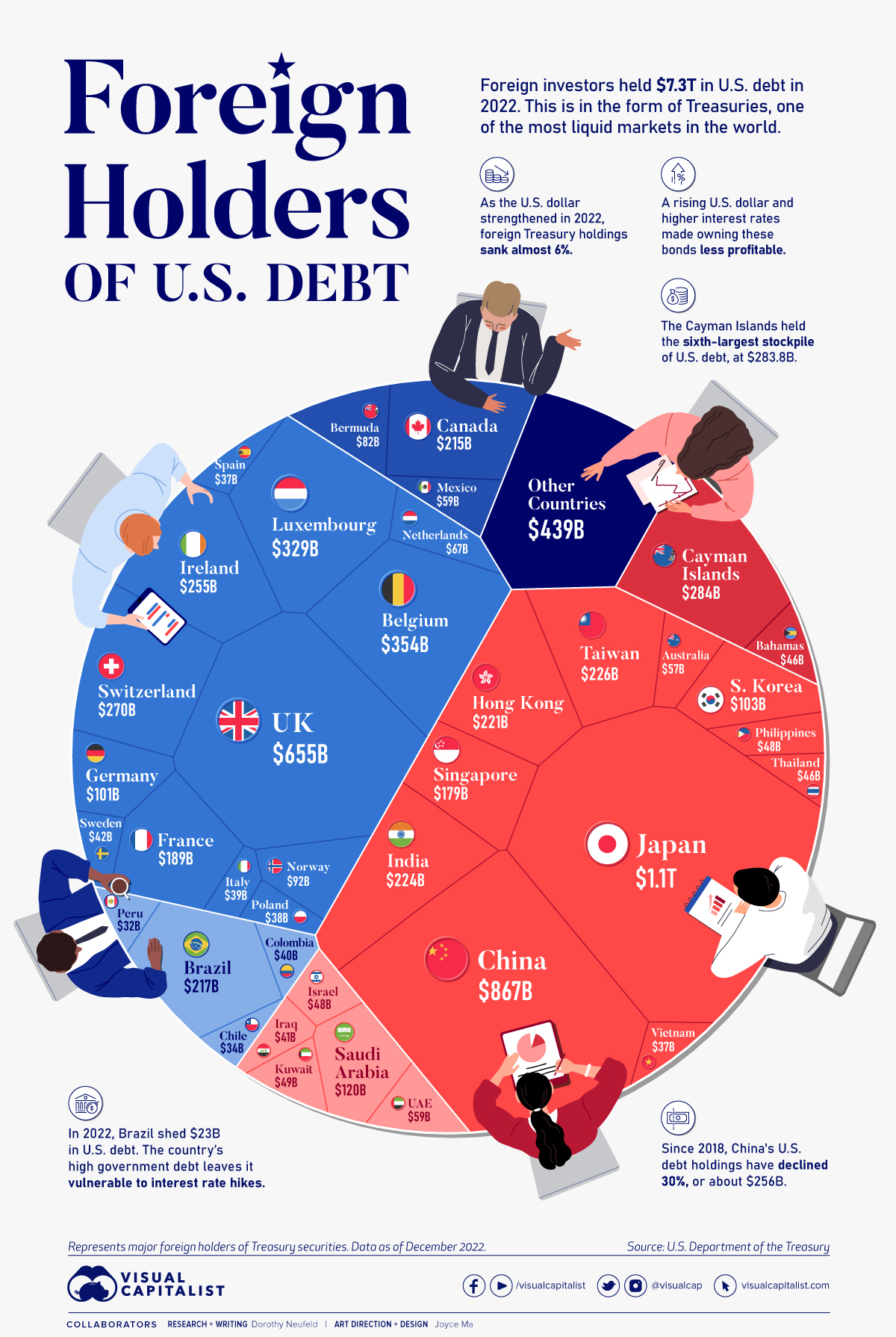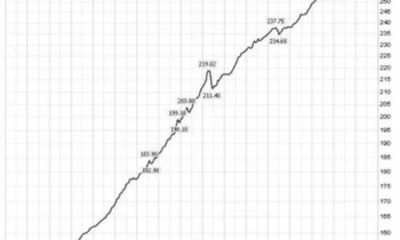Economics
Which Countries Hold the Most U.S. Debt?
Foreign investors hold $7.3 trillion of the national U.S. debt. These holdings declined 6% in 2022 amid a strong U.S. dollar and rising rates.
The post…


Yes. Visualizations are free to share and post in their original form across the web—even for publishers. Please link back to this page and attribute Visual Capitalist.
Licenses are required for some commercial uses, translations, or layout modifications. You can even whitelabel our visualizations. Explore your options.
Click here to license this visualization.
Which Countries Hold the Most U.S. Debt in 2022?
Today, America owes foreign investors of its national debt $7.3 trillion.
These are in the form of Treasury securities, some of the most liquid assets worldwide. Central banks use them for foreign exchange reserves and private investors flock to them during flights to safety thanks to their perceived low default risk.
Beyond these reasons, foreign investors may buy Treasuries as a store of value. They are often used as collateral during certain international trade transactions, or countries can use them to help manage exchange rate policy. For example, countries may buy Treasuries to protect their currency’s exchange rate from speculation.
In the above graphic, we show the foreign holders of the U.S. national debt using data from the U.S. Department of the Treasury.
Top Foreign Holders of U.S. Debt
With $1.1 trillion in Treasury holdings, Japan is the largest foreign holder of U.S. debt.
Japan surpassed China as the top holder in 2019 as China shed over $250 billion, or 30% of its holdings in four years.
This bond offloading by China is the one way the country can manage the yuan’s exchange rate. This is because if it sells dollars, it can buy the yuan when the currency falls. At the same time, China doesn’t solely use the dollar to manage its currency—it now uses a basket of currencies.
Here are the countries that hold the most U.S. debt:
| Rank | Country | U.S. Treasury Holdings | Share of Total |
|---|---|---|---|
| 1 | Japan | $1,076B | 14.7% |
| 2 | China | $867B | 11.9% |
| 3 | United Kingdom | $655B | 8.9% |
| 4 | Belgium | $354B | 4.8% |
| 5 | Luxembourg | $329B | 4.5% |
| 6 | Cayman Islands | $284B | 3.9% |
| 7 | Switzerland | $270B | 3.7% |
| 8 | Ireland | $255B | 3.5% |
| 9 | Taiwan | $226B | 3.1% |
| 10 | India | $224B | 3.1% |
| 11 | Hong Kong | $221B | 3.0% |
| 12 | Brazil | $217B | 3.0% |
| 13 | Canada | $215B | 2.9% |
| 14 | France | $189B | 2.6% |
| 15 | Singapore | $179B | 2.4% |
| 16 | Saudi Arabia | $120B | 1.6% |
| 17 | South Korea | $103B | 1.4% |
| 18 | Germany | $101B | 1.4% |
| 19 | Norway | $92B | 1.3% |
| 20 | Bermuda | $82B | 1.1% |
| 21 | Netherlands | $67B | 0.9% |
| 22 | Mexico | $59B | 0.8% |
| 23 | UAE | $59B | 0.8% |
| 24 | Australia | $57B | 0.8% |
| 25 | Kuwait | $49B | 0.7% |
| 26 | Philippines | $48B | 0.7% |
| 27 | Israel | $48B | 0.7% |
| 28 | Bahamas | $46B | 0.6% |
| 29 | Thailand | $46B | 0.6% |
| 30 | Sweden | $42B | 0.6% |
| 31 | Iraq | $41B | 0.6% |
| 32 | Colombia | $40B | 0.5% |
| 33 | Italy | $39B | 0.5% |
| 34 | Poland | $38B | 0.5% |
| 35 | Spain | $37B | 0.5% |
| 36 | Vietnam | $37B | 0.5% |
| 37 | Chile | $34B | 0.5% |
| 38 | Peru | $32B | 0.4% |
| All Other | $439B | 6.0% |
As the above table shows, the United Kingdom is the third highest holder, at over $655 billion in Treasuries. Across Europe, 13 countries are notable holders of these securities, the highest in any region, followed by Asia-Pacific at 11 different holders.
A handful of small nations own a surprising amount of U.S. debt. With a population of 70,000, the Cayman Islands own a towering amount of Treasury bonds to the tune of $284 billion. There are more hedge funds domiciled in the Cayman Islands per capita than any other nation worldwide.
In fact, the four smallest nations in the visualization above—Cayman Islands, Bermuda, Bahamas, and Luxembourg—have a combined population of just 1.2 million people, but own a staggering $741 billion in Treasuries.
Interest Rates and Treasury Market Dynamics
Over 2022, foreign demand for Treasuries sank 6% as higher interest rates and a strong U.S. dollar made owning these bonds less profitable.
This is because rising interest rates on U.S. debt makes the present value of their future income payments lower. Meanwhile, their prices also fall.
As the chart below shows, this drop in demand is a sharp reversal from 2018-2020, when demand jumped as interest rates hovered at historic lows. A similar trend took place in the decade after the 2008-09 financial crisis when U.S. debt holdings effectively tripled from $2 to $6 trillion.

Driving this trend was China’s rapid purchase of Treasuries, which ballooned from $100 billion in 2002 to a peak of $1.3 trillion in 2013. As the country’s exports and output expanded, it sold yuan and bought dollars to help alleviate exchange rate pressure on its currency.
Fast-forward to today, and global interest-rate uncertainty—which in turn can impact national currency valuations and therefore demand for Treasuries—continues to be a factor impacting the future direction of foreign U.S. debt holdings.
The post Which Countries Hold the Most U.S. Debt? appeared first on Visual Capitalist.
dollar
policy
interest rates
exchange rate policy
store of value

Argentina Is One of the Most Regulated Countries in the World
In the coming days and weeks, we can expect further, far‐reaching reform proposals that will go through the Argentine congress.
Crypto, Crude, & Crap Stocks Rally As Yield Curve Steepens, Rate-Cut Hopes Soar
Crypto, Crude, & Crap Stocks Rally As Yield Curve Steepens, Rate-Cut Hopes Soar
A weird week of macro data – strong jobless claims but…
Fed Pivot: A Blend of Confidence and Folly
Fed Pivot: Charting a New Course in Economic Strategy Dec 22, 2023 Introduction In the dynamic world of economics, the Federal Reserve, the central bank…



















